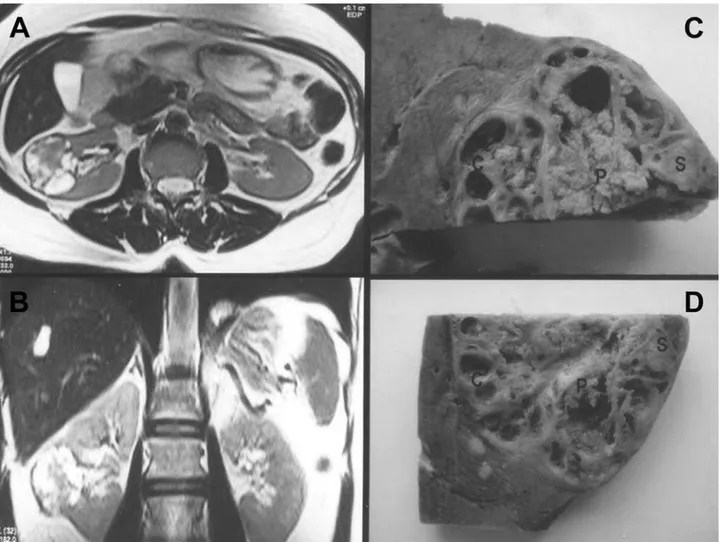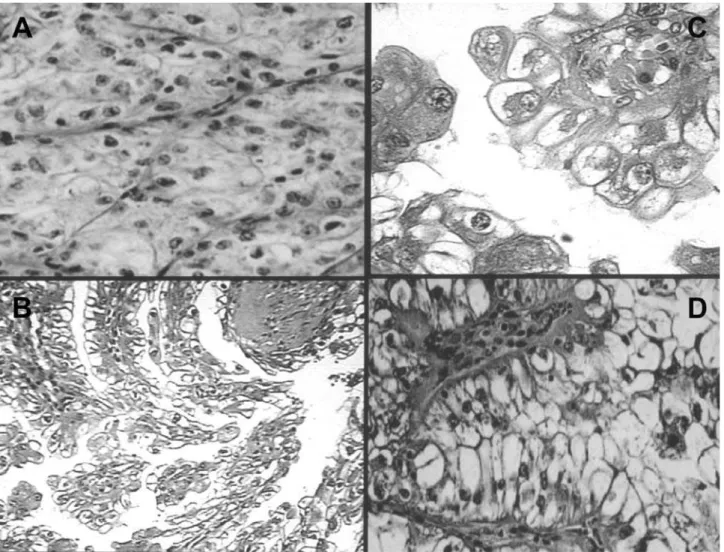KIDNEY CARCINOMA ASSOCIATED WITH XP11.2 TRANSLOCATION /
TFE3 (ASPL-TFE3) GENE FUSION
PAULO G. O. SALLES, MARIO SOTO JR
Biocor Hospital, Belo Horizonte, Minas Gerais, Brazil
ABSTRACT
We report the case of a 58-year old patient, showing a solid image in the right kidney, who underwent radical nephrectomy that revealed neoplasia, whose pathological study led to the diagnosis of kidney carcinoma associated with Xp11.2 translocation / TFE3 (ASPL-TFE3) gene fusion. The authors discuss aspects related to this lesion, such as frequency, pathogenesis, clinical presentation, histopathology and outcome, as observed in the literature.
Key words: kidney neoplasms; renal cell; nephrectomy; TFE3 protein, human
Int Braz J Urol. 2005; 31: 251-5
INTRODUCTION
Kidney carcinomas associated with Xp11.2 translocations / TFE3 gene fusions are present in the new version of the WHO classification of kidney tu-mors (2004) (1). They are defined by a number of different translocations involving the Xp11.2 chro-mosome, all of them resulting from genic fusions in-volving the TFE3 gene. It is an uncommon tumor, with approximately 30 reports in international litera-ture, with no Brazilian publications, whose morphol-ogy and biological behavior are not widely recognized as yet (1-3).
CASE REPORT
Female 58-year old patent reported infre-quent episodes of nephritic colic during the past 6 months. The physical examination revealed no sig-nificant changes, as well as the exam of urinary sedi-ment and urine culture. Imaging examinations (Fig-ure-1) showed a nodule in the middle third of right kidney. Considering this finding, after a discussion
on surgical approach and management with the pa-tient, we opted for a right radical nephrectomy. The surgical procedure was performed without any intercurrence, and immediate post-operative out-come was satisfactory.
eosi-nophilic and granular cytoplasm, limited by quite distinctive edges (Figure-2). Metastases were seen in 3 of the 6 dissected lymph nodes, thus determin-ing a final stagdetermin-ing (TNM 2002) pT1b pN2 pMX (stage IV). Based on the aforementioned morphologi-cal findings, immunohistochemimorphologi-cal analysis was per-formed in order to search for the TFE3 protein, with positive result. The set of morphological and immu-nohistochemical findings confirmed the diagnosis of renal cell carcinoma associated with Xp11.2 translo-cation / TFE3 (ASPL-TFE3) gene fusion. After ap-proximately 6 months of follow-up, the patient shows favorable outcome, without manifesting disease or any other signs or symptoms.
COMMENTS
comas (1-3). A chromosome translocation is an aber-ration associated with a change in the chromosomal structure: a segment from one chromosome is trans-ferred to another one. This kind of change allows the recombination of unrelated sequences from different chromosomes, with the formation of hybrid genes. Such genes (then considered as oncogenes), in turn, can eventually encode chimeric (mutant) proteins that would act as mediators related to cell growth and motility, potential for invasion and cellular morpho-genetic differentiation. Thus, recognizing and study-ing such chromosomal change could have a
funda-mental role for understanding carcinogenesis, as well as for diagnosing and determining prognostic factors associated with kidney carcinomas (2,3).
fined limits, and nuclei containing vesicular chro-matin and prominent nucleoli. Scattered hyaline nod-ules and psammomatous bodies can be seen. Such findings can vary according to the different variants (ASPL-TFE3 tumors have cells with less abundant cytoplasm, more hyaline nodules and psammoma-tous bodies, and are less solid than PRCC-TFE3 tu-mors). The immunohistochemical analysis reveals the nuclear labeling for the chimeric protein TFE3, which is produced by the fusion of genes that en-code chimeric proteins composed by the C-terminal portion of TFE3 and by N-terminal portions of other translocated segments, which constitutes the most distinctive feature in these neoplasias; expression of CD10 and RCC (renal cell carcinoma marker an-tigen) has been described, but only 50% express epithelial markers (EMA and cytokeratin, for ex-ample) (1-4). Differential diagnosis includes papil-lary and conventional (clear cell) renal cell carcino-mas. In relation to outcome, little is known about the clinical behavior of these carcinomas: the lit-erature reports that tumors ASPL-TFE3, despite their advanced stage, usually presented slow progression (1-2). In summary, it is a rare renal tumor, with pe-culiar morphogenetic characteristics and biological behavior, which must be recognized by specialists.
Dr. Pedram Argani, Johns Hopkins University Hospital,Baltimore, MD, USA, performed the immunohistochemical analysis.
REFERENCES
1. Tumours of the Kidney. In: Eble JN, Sauter G, Epstein JI, Sesterhenn I (eds.). WHO Classification of Tumours: Tumours of the Urinary System and Male Genital Organs. Lyon, IARC Press. 2004, pp. 9-88. 2. Argani P, Antonescu CR, Illei PB, Lui MY, Timmons
CF, Newbury R, et al.: Primary renal neoplasms with the ASPL-TFE3 gene fusion of alveolar soft part sar-coma: a distinctive tumor entity previously included among renal cell carcinomas of children and adoles-cents. Am J Pathol. 2001; 159: 179-92.
3. Argani P, Antonescu CR, Couturier J, Fournet JC, Sciot R, Debiec-Rychter M, et al.: PRCC-TFE3 renal carci-nomas: morphologic, immunohistochemical, ultra-structural, and molecular analysis of an entity associ-ated with the t(X;1)(p11.2;q21). Am J Surg Pathol. 2002; 26: 1553-66.
4. Argani P, Lal P, Hutchinson B, Lui MY, Reuter VE, Ladanyi M. Aberrant nuclear immunoreactivity for TFE3 in neoplasms with TFE3 gene fusions: a sensi-tive and specific immunohistochemical assay. Am J Surg Pathol. 2003; 27: 750-61.
Received: January 11, 2005 Accepted after revision: April 29, 2005
Correspondence address:
Dr. Paulo G. de Oliveira Salles Rua Pitangueiras 554
Belo Horizonte, MG, 30350-200, Brazil Phone.: + 55 31 3296-9851
EDITORIAL COMMENT
The WHO has recently presented a new sification for renal cell carcinomas in 2004. This clas-sification included renal carcinomas with fusion of the ASPL gene, which is present in alveolar soft part sarcoma alveolar, and the PRCC gene, found in pap-illary renal cell carcinoma. Jointly, theses tumors have been denominated as carcinomas with translocation of TFE3 gene in Xp 11.2 (PRCC-TFE3 and ASPL-TFE3).
Recent information from European patholo-gists and from the John Hopkins University show that a large percentage of renal carcinomas occurring in
the first decades of life present TFE3 translocations, thus suggesting that this group of tumors that are cur-rently described, under a pathological perspective, as typical renal cell carcinomas, are in fact genetically and phenotypically different from conventional tu-mors.
The case described in this paper is interest-ing; furthermore, it reports an adult patient, which is an uncommon fact. The real clinical significance of this gene fusion is still unknown, but it could possi-bly indicate tumors that are sensitive to different che-motherapy agents.

